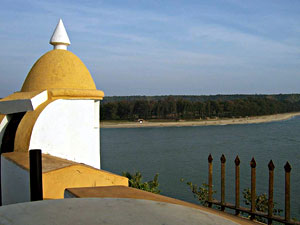|
|
Goa Forts
....................................................................................... |
|
As the Portuguese gradually extended their
empire to east from Lisbon they built a series of coastal
forts to protect their essentially seaboard possessions and to
dominate the Arabian sea and East Indies. With their superior
naval power, they could blow most ‘country boats’ out of
water. The purpose of Goa was to supervise the Malabar coast.
The forts are small compared with even the modest Indian
forts, due the small number of expatriate Portuguese manning
them. There were inland forts at Chandor, Bicholim and Alorna
in the North east corner of the state. Alorna was acquired by
the Portuguese from the Bhonsla in 1746 and lies in a ruined
pile on the northern banks of the Chapora river. |
|
|
|
Tiracol Fort
Tiracol Fort is the most northerly of the forts and stands on
the northern side of the Teracol river estuary. Like all
the other forts it is situated on a piece of high
ground. Fortified from attacks from the sea, the walls
on the land side, rise from a dry moat. The view across
the estuary is very picturesque. The church inside the
fort has a classic Goan façade and is large enough to
have catered for the occupants of the fort and the
surrounding settlements.
|
 |
|
|
Chapora (Shapur) Fort
Chapora (Shapur) fort, now in ruins, stand on the S bank of
the Chapora River and dominates the estuary. It was originally
built by the Adil Shah. Aurangzeb’s son Akbar used it as his
headquarters.
Reis Magos
Reis Magos is 2.5 km east along the north bank of the Mandovi
from Fort Aguada and faces Panaji across the river. It is a
small town of some charm with a fort that was constructed in
1551 by Don Alfonso de Noronha. It was intended as a second
line of defence should an enemy manage to sail past Aguda and
Cabo on the headlands. The turreted walls are in almost
perfect condition and house a local prison. The Franciscan
Church of Reis Magos (1550) stands alongside and is one of the
first Goan churches. Both stand quite high above water level
and are approached by a flight of steep steps.
Cabo de Raj Niwas
Cabo de Raj Niwas stands opposite Fort Aguada and was begun as
early as 1540. A Franciscan monastery was built alongside.
During the Napoleonic Wars British troops were garrisoned at
Cabo and built themselves barracks which were subsequently
demolished by the Portuguese. Later the Archbishop of Goa was
given the monastery as his residency which later became the
governor’s residence of Raj Bhawan. The second line of defence
on this side of the estuary was Gaspar Dias near Miramar
Beach, 2 km from Cabo de Raj Niwas. It was destroyed during
the mutiny of 1835.
|
|
|
|
Aguada Fort
Aguada Fort on the northern tip of the Mandovi estuary
with the neerul river to the east, was the strongest of
the Portuguese coastal forts, completed in 1612. A
channel was excavated to make the headland an island and
a large well and a number of springs, provided the fort
with drinking water (agoa) as well as to passing ships.
The main fortifications are still intact, particularly
at the water’s edge. Seventy nine guns were placed to
give the fort all round defensive fire power and the
Church |
 |
|
|
of St
Lawrence stood in the centre of the fort. A 13 m high lamp lit
on the birthday of Queen Maria Pia of Portugal. During World
War II German prisoners of war were interned in the fortress
which later served as the Central Jail. The Taj Holiday
Village, Fort Aguada and Hermitage now occupy the area and
have been constructed with great architectural and
environmental sensitivity.
Marmagao Fort
Virutally nothing remains of Marmagao fort on the southern
headland of Mormugao Bay. Non-combatants were moved here from
Old Goa when it was under threat in 1683 and at one time there
was scheme to shift the capital here. Along with Aguada,
Mormugao was the ‘throat’ throught which Goa breathed and is
one of the finest natural harbours along the western seaboard
of India. Vasco da Gama has been developed into a modern port.
Cabo de Rama
The southernmost fort is Cabo de Rama, named after the hero of
the Ramayana Hindu epic who is said to have lived there with
his wife Sita during their period of exile. The site was
chosen well as the narrow headland only needed fortification
on the landward side. Its origins pre-date the arrival of the
Portuguese who acquired it in 1763 and was used as a prison.
There are two springs, one of which gives out water through
two spouts at different temperatures. Not easily accessible by
road, it is best seen by boat.
Rachol Fort
The Rachol Fort, mostly in ruins, was one of the most ancient
fort in Goa. Originally Muslim it was captured by the forces
of Vijayanagar in 1520 and then ceded to the Portuguese.
During the Maratha Wars of 1737-9 it was heavily armed by the
Portuguese with approximately 100 cannons. During the siege
that followed it was greatly damaged. The result of the War
was that the northern provinces were lost and in order to keep
the southern ones, the Portuguese paid a huge war indemnity.
The fort was repaired by the Marguis of Alorna in 1745 but
with the threat of aggression removed most of the buildings
gradually disintegrated over the ensuing years. |
|